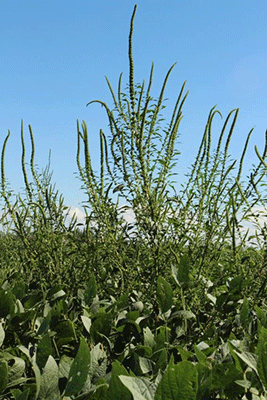By Robert Hartzler

Palmer amaranth is an invasive weed that is native to the southwestern United States. Over the last three years, however, the weed has made its way into Iowa and has been identified in at least nine counties, most recently in Madison, Clayton, Washington and Crawford counties.
Palmer amaranth is related to waterhemp, a common weed found across Iowa. In addition to traditional weedy traits, the characteristic that makes those two weeds unique and hard to manage is their ability to evolve resistance to herbicides, according to Bob Hartzler, professor of agronomy and extension weed specialist at Iowa State University.
“Both weeds are adapted to a production system that relies on herbicides,” said Hartzler. “Waterhemp is a relatively non-competitive weed so many farmers have learned to accept lower levels of weed control. If Palmer amaranth spreads across the state and farmers try to manage it like they do waterhemp, it will have a huge negative economic impact.”
The known cases of Palmer amaranth in the state are isolated right now, and keeping it from spreading is the immediate need.
“Palmer amaranth built its reputation on how it devastated the cotton industry in the south after the near complete reliance on glyphosate in Roundup Ready cotton,” Hartzler said. “The best way to manage it is to slow its spread into and within the state. This is a highly competitive weed that has adapted to our current management system for corn and soybean crops.”
Potential Crop impact from Habitat Restoration Areas
The initial Palmer amaranth infestations in Iowa were found in crop fields associated with equipment and inputs from outside of the state. More recently, Palmer amaranth has been found on ground set aside for conservation practices. The weed most likely will not persist in these new locations being established for conservation habitat since the Palmer amaranth should be crowded out once native, perennial vegetation is established. The concern, however, is that until the perennial plants become established, Palmer amaranth may produce enough seed to begin moving into neighboring corn and soybean fields.
“With Palmer amaranth being so much more competitive than waterhemp it could have a significant economic impact due to higher weed management costs and greater yield losses,” said Hartzler.
Identifying Palmer Amaranth and Treatment
In the video below Hartzler describes Palmer amaranth and how to identify the weed. It can be viewed at https://vimeo.com/178360206.
Hartzler said Palmer amaranth needs to be identified early so it can be eradicated before it has an opportunity to establish itself. The difficulty arises because of how closely Palmer amaranth resembles waterhemp; the two weeds are virtually identical in their early growth stages.
The one consistent vegetative trait that can be used to differentiate Palmer amaranth from waterhemp is the relative length of the leaf petiole and leaf blade. After removing a leaf from the stem, bend the leaf backward so it lays over the leaf blade. If the petiole is longer than the blade, the weed in question is most likely Palmer amaranth. Not all leaves on a Palmer amaranth have this trait, but most plants will have some leaves with the long petiole.
Female Palmer amaranths have long bracts (modified leaves on the flower stem) that extend well beyond the other floral parts of the weed. As the plants mature these bracts become sharp and painful to the touch while waterhemp bracts remain soft. The flowering branches on Palmer amaranth are longer than those of waterhemp, and have a spiky appearance because of the large bracts.
Treatment
“The one thing we have going for us is that every corn and soybean field has waterhemp, so farmers have developed weed management programs targeting waterhemp,” said Hartzler.
“Programs that are effective on waterhemp should provide effective control of Palmer amaranth. That alone will make it hard for the weed to spread rapidly. However, Palmer amaranth is more aggressive and grows more rapidly than waterhemp so that reduces the window of opportunity to implement control tactics,” he said.
Much of the state’s waterhemp is already resistant to glyphosate (Roundup), and it is likely Palmer amaranth will carry that same resistance. Farmers need to develop diversified weed management programs that use multiple herbicide sites of action and include alternative management strategies to delay further selection of herbicide resistant weeds.
Conservation Habitats
While new detections of Palmer amaranth have been found in ground reserved for non-crop habitat restoration, there are ways to manage the weed while also continuing to grow the vegetation needed to support water quality and game birds, pollinators and other wildlife populations.
“The standard management practices for establishing native planting habitat is to mow that area three or four times during the first year because the weeds will take off much quicker than native plants. Additional mowing may also be needed in the second year after planting,” Hartzler said. “There is no reason to fear establishing this type of habitat, but anyone who does should become familiar with Palmer amaranth so they can distinguish it from waterhemp or other weeds in the area. In many of the infested fields the number of Palmer amaranth plants was low enough to allow for the hand removal of the plants.”